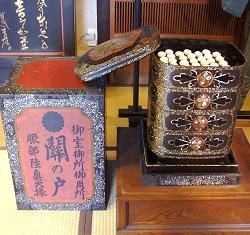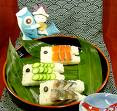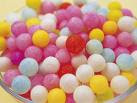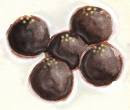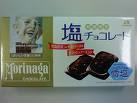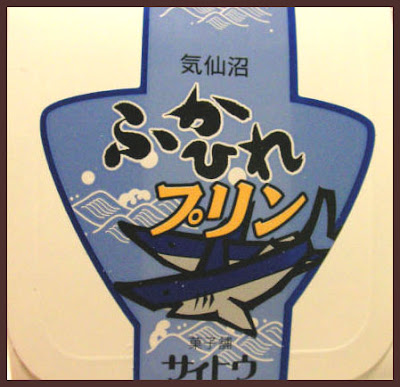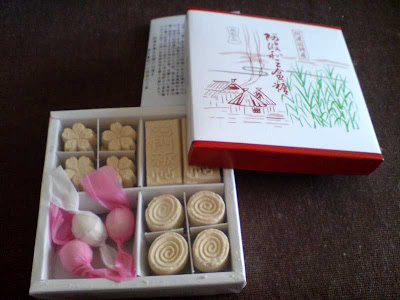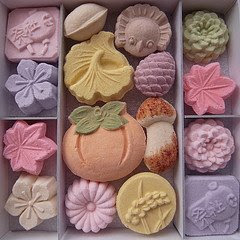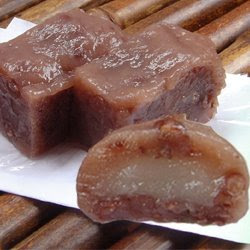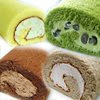[ . BACK to WORLDKIGO TOP . ]
::::::::::::::::::::::::::::::::::::::::::::::::::::::::::::::::::::::::::::::::::::::::::::::::::::
Dumplings for Moon Viewing (tsukimi dango)
***** Location: Japan
***** Season: Mid-Autum
***** Category: Humanity
*****************************
Explanation
Moon viewing is a duty on the full moon night of Autumn in Asia, dating back more than 3000 years !
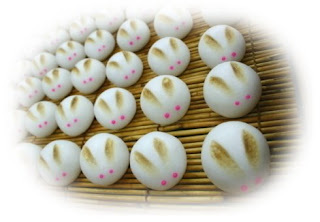 Dumplings with the hare in the moon !
Dumplings with the hare in the moon !
I have a special plate of Bizen pottery for moonviewing dumplings. It has a full moon in the top corner.

This is a similar plate, tsukimi sara 月見皿, found online.
:::::::::::::::::::::::::::::::::::::::::::::::::::::::::::::::::::::::::::::::::::::::::::::::::::
Other KIGO food consumed on this night:
Edamame 枝豆 (えだまめ) green soy beans
tsukimi mame 月見豆(つきみまめ)
Tsukimizake, 月見酒(つきみざけ)rice wine for moon viewing
:::::::::::::::::::::::::::::::::::::::::::::::::::::::::::::::::::::::::::::::::::::::::::::::::::
The custom of moon viewing held in mid-autumn is called
tsukimi in Japan. It's said that this moon viewing custom was introduced to Japan from China during Nara and Heian periods (710-1185).
Tsukimi takes place on August 15th in the lunar calendar, so it's called
jugoya, which means the night of 15th. Jugoya in the solar calendar changes every year and usually falls on September or October. The moon on jugoya isn't always full, but it's said that the moon on the night is the brightest and the most beautiful in the year.
How do Japanese people celebrate Tsukimi?
It's done in a quiet manner. Traditionally, susuki (pampas grass) or other autumn flowers are decorated in a vase, and
dango (dumplings) and
satoimo (taro potatoes) are offered to the moon in an alter. People look at the moon, enjoying the beauty quietly. Tsukimi also has the meaning of celebrating the autumn harvest.
Commonly, plain dumplings are stacked on a tray instead of skewered.
The word,
tsukimi, is used in Japanese food as well.
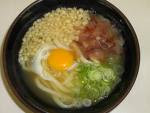 tsukimi udon noodles
tsukimi udon noodles
For example,
tsukimi-soba and
tsukimi-udon are well-known. They aren't food for moon viewing. Tsukimi indicates a
cracked egg in Japanese cooking since the egg yolk resembles the moon. Tsukimi udon/soba are hot udon/soba noodle soup with raw egg toppings.
McDonald's in Japan even sells
tsukimi burgers, which are hamburgers with fried egg fillings.
source : japanesefood.about.com . Setsuko Yoshizuka
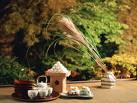 quote
quote
On the evening of the full moon, it is traditional to gather in a place where the moon can be seen clearly, decorate the scene with Japanese pampas grass, and to serve white rice dumplings (known as Tsukimi dango), taro, edamame, chestnuts and other seasonal foods, plus sake as offerings to the moon in order to pray for an abundant harvest. These dishes are known collectively as Tsukimi dishes (月見料理, tsukimi ryoori). Due to the ubiquity of sweet potato or taro among these dishes, the tradition is known as Imomeigetsu (芋名月) or "Potato harvest moon" in some parts of Japan.
There are specific terms in Japanese to refer to occasions when the moon in not visible on the traditional mid-autumn evening, including Mugetsu (無月 literally: no-moon) and Ugetsu (雨月 rain-moon). Even when the moon is not visible, however, Tsukimi parties are held.
© More in the WIKIPEDIA !
WKD : Temple Ginkakuji 銀閣寺, a place for moon viewing
Silver Pavilion in Kyoto
Kogetsudai, Moon-viewing Platform
:::::::::::::::::::::::::::::::::::::::::::::::::::::::::::::::::::::::::::::::::::::::::::::::::::::
tsukimi dango from Nagoya名古屋 月見団子

They come in three colors, brown (with raw sugar), white (plain) and pink (with
shokubeni food coloring). They are not round but oblong, with a sharper edge.
They resemble the form of a taro root, the brown one with the skin, the white one without the skin, as an expression for the Harvest Thanksgiving for the
Imo Meigetsu taro potato moon.
The pink one was "invented" about 30 years ago, when families made them at home and added this color to please the little children.
:::::::::::::::::::::::::::::::::::::::::::::::::::::::::::::::::::::::::::::::::::::::::::::::::::::
quote
Dango are dumplings which can be either savory or sweet and are often, but not always, served on a bamboo skewer. Savory dango are many times covered in some type of soy-based sauce, which can either be sweet, salty or both, and can be served with nori sprinkled on top or completely wrapped in a sheet of seaweed.
There’s an incredible variety of sweet dessert-style dango, which makes the amount of savory varieties pale in comparison. Sweet dango can be filled, topped or crafted with all manner of traditional Japanese dessert (wagashi) foodstuffs. A few of these traditional ingredients include anko (also known as an), goma (black sesame) and kinako (roasted soybean flour).
First, let’s break down the different ways of making dango, including cooking methods, ingredients, and end with varieties.
Cooking
Technically, all dango are cooked in some manner. There are many ways to prepare and cook dango, varying in degrees of simplicity and difficulty.
Boiling
The easiest way to make dango is:
Mix together mochiko and water
Make mochiko dough into balls
Drop balls in boiling water, soup or other liquid
Cook for about fifteen minutes
Steaming
The next step up from boiling would be:
Form the mochiko dough into balls
Steam the dango
Skewer the balls (optional)
Roast the dango (optional)
Twice Cooked
Higher up on the dango difficulty scale is what I call twice-cooked dango. To make this dango:
Reduce dango batter from a viscous liquid to a solid dough
Form dough into balls
Thread balls on skewers and steam
Shiro An Method
This is a complex method of making dango, but will yield unique dumplings with an interesting flavor and texture:
Mix mochiko with shiro koshian
Steam mixture and work sugar into mix
Add additional ingredients
Form into balls and skewer
Flours
Mochiko, glutinous rice flour, is what gives dango their super chewy, gooey texture. Shiratamako, another glutinous rice flour, is also used to make dango. A dango recipe made entirely from mochiko or shiratamako will result in a very soft dango.
Shiratamako is lumpy, and must be dissolved in water or ground before using in a recipe. I’ve heard mochiko can be used interchangeably with shiratamako with little to no adverse results. I personally have used mochiko in place of shiratamako and haven’t noticed the difference. Mochiko is also waaaay cheaper than shiratamako, especially if it’s bought under the name “sweet rice flour”.
Joshinko, non-glutinous rice flour, can be added in varying amounts to create a firmer dango. I recommend a ratio of no more than 1:1 of mochiko to joshinko for dango which is firm but still has some gooey mouth feel. Anything above that results in a denser, less chewy, harder dango.
. Shiratama Dango dumplings
Liquids
Water is normally used as in making dango, and boiling water at that. However, nothing’s keeping you from substituting other liquids or semi-liquids (anko, mashed fruit, pumpkin filling, etc.) for a portion or all of the water. Fruit or vegetable juice, rose water, milk, tea, or coffee can all be added to dango to enhance the flavor and change the texture. Also, extracts and concentrated flavorings can be added to alter the flavor.
The more liquid used in dango, the softer and gooier it will be. Less water will create a firmer dango, but will also result in a drier dango. Keep in mind you want the liquids hot, unless you plan on cooking the dango ingredients together anyway. Boiling the liquids will dissolve sugars and help bind the mochiko to the other ingredients, which in turn results in smoother, less gritty dango.
Additives
Certain additives, such as powders, non-rice flours, beans, nuts and seeds can be added to the dough, but it’s important to keep in mind how they’ll effect the texture of the finished dango. Small amounts of powdered spices, espresso powder, cocoa, matcha and powdered milk can be added to the rice flour(s) or dissolved in the water/ juice to create flavored dough. Experimentation with amounts is important in finding a recipe that works with your preferred texture and flavorings.
Toppings
After the dango are steamed and/or toasted, it’s your choice what you top them with, if at all. I personally am a huge fan of anko and goma an (black sesame seed paste) on my plain toasted dango. Drowning freshly browned dango in a sea of beans and sesame seeds is more yummy than it sounds. It’s up to you, though, to choose what to cover your dango with.
Some traditional ideas are:
Tsubu An: Chunky bean paste
Koshi An: Smooth bean paste
Shiro An: White bean paste
Goma An: Black sesame paste
Kurumi: Walnut powder
Kuri: Chestnut powder or paste
Kinako: Roasted soy bean flour
Mitarashi: Sauce similar to teriyaki
Matcha An: Green tea paste
Zunda: Dango topped with slightly sweetened green soybean paste
Nori: Savory dango wrapped in seaweed
Dango Varities
Dango are named after their toppings, their added ingredients to the dough and their fillings. The above are a sampling of dango named after toppings (goma dango, an dango) but there are also dango named after what’s in the dough and the finished dango or how they’re cooked:
Matcha Dango: Green tea powder flavored dango
Kibi dango: Dango made with millet starch
黍団子(きびだんご)
kigo for late autumn
Yomogi/ Kusa Dango: Mugwort flavored dumplings (kusa dango were originally flavored with cudweed)
Gomasuri Dango: Lil’ dumplings filled with black sesame paste
Zunda dango: Dango filled with green soybean paste
Sasa Dango: Dumplings filled with anko and steamed in bamboo leaves
Kushi Dango: Skewered dumplings
Sanshoku Dango (Three Color Dumplings: Sanshoku (three colors): Dumplings made with three colors. Contrary to popular belief, sanshoku dango does not refer to a specific variety. Any dango with three colors is sanshoku dango, including hanami and botchan dango.
Dango are also named for festivals and even fictional characters!
Hanami Dango (Flower Viewing Dumplings): Three dango on a skewer. Colors are pink (food coloring), white (plain) and green (matcha, yomogi or food coloring). Hanami dango are eaten during cherry blossom season.
Tsukimi Dango (Moon Viewing Dumplings): Non-skewered filled or plain dumplings. Usually presented as a pyramid shaped pile of dumplings, tsukimi dango are eaten during the moon viewing festival. I’ve seen ornate tsukimi dango shaped like usagi (bunnies!) as a homage to the mochi pounding rabbit in the moon.
Ikinari Dango (All of a Sudden Dango): Don’t know why this is called dango, but this daifuku-looking dumpling is made with satsumaimo topped with anko, wrapped with mochiko dough and then cooked. It’s a specialty from Kumamoto where it gets its name from being so easy to make. If visitors pop by, all of a sudden, ikinari dango is so simple, it can be whipped up in minutes.
Botchan Dango (Named after a fictional character): Three dango on a skewer made from red beans, matcha and egg yolk.
source : theanimeblog.com
Imodango, imo dango with sweet potatoes
© More in the WIKIPEDIA !
::::::::::::::::::::::::::::::::::::::::::::::::::::::::::::::::::::::::::::::::::::::::::::::::::::
Other types of DANGO
(not all are kigo)
agari dango 上蔟団子(あがりだんご)
dango to celebrate the finished silk cocoons
kigo for early summer
botan dango ぼたん団子 dango filled with anko sweet bean paste
Served at the shrine Yakyu Jinja (yakyuu jinja)「箭弓(やきゅう)神社」/ 箭弓神社
. . . CLICK here for Photos of the Peony Park!
The shrine has a famous peony park. Saitama prefecture, Higashi Matsuyama 東松山.
. . . CLICK here for Photos !
The shrine is famous for its ema votive plaques in the form of a baseball bat (the name YAKYUU also means baseball in Japanese.)
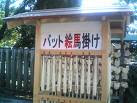
バット絵馬 batto ema
The Chinese characters of the shrine name mean
"arrow YA (矢/箭) and bow KYU 弓" .
:::::::::::::::::::::::::::::::::::::::::::::::::::::::::::::::::::::::::::::::::::::::::::::::::::::
DANGO kigo for the new year
dango shoogatsu 団子正月(だんごしょうがつ)
dango for the New Year
They are eaten on January 20. In some areas, the dango are placed in kayu rice grues.
misoka dango 晦日団子(みそかだんご)
dango eaten on January 30
. mayudango 繭団子(まゆだんご)
dumplings like silk worm cocoons
dangobana 団子花(だんごばな)"dumplings looking like blossoms"
juuyokka dango 十四日団子(じゅうよっかだんご)
dango eaten on day 14 of the lunar first month
(now January 14)
To pass safely over into a new circle with the full moon on lunar first month, day 15.
With the wish for health and prosperity.
..... juuyokka toshikoshi --- to pass into the new year on the 14th
十四日年越 (じゅうよっかとしこし)
.................................................................................
dangoimo, dango-imo 団子芋(だんごいも)
sweet potatoes suitabel to make into dumplings
kigo for all autumn
. dangomaki, dango maki 団子撒き(だんごまき)
throwing dango
during the Nehan ceremony of Shakyamuni Buddha
kigo for mid-spring
. WASHOKU
fuchagi ふちゃぎ mochi for moon viewing
from Okinawa
. hatsu-uma dango 初午団子(はつうまだんご)
dango eaten on the first day of the horse
kigo for early spring
higan dango 彼岸団子(ひがんだんご)
dango for the spring equinox
kigo for mid-spring
Imodango 芋だんごdumplings with sweet potatoes as base
From Kagoshima and Shodoshima
kinpira dango キンピラ団子 with simmered rood vegetables
speciality of Niigata
. mitarashi dango 御手洗団子(みたらしだんご)
kigo for late summer
Kyoto at Shrine Shimogamo Jinja in Kyoto 京都の下鴨神社.
Saruiwa kibidango, saru-iwa kibidango 猿岩きびだんご millet balls
from "Monkey Rock" Saruiwa
This is a rock on the island of Iki 壱岐, which looks just like a monkey.
The island has a legend connecting to the story of Momotaro and the demons.
CLICK here for PHOTOS !
::::::::::::::::::::::::::::::::::::::::::::::::::::::::::::::::::::::::::::::::::::::::::::::::::::
sendango 千団子 (せんだんご ) "1000 dango"
千団子祭(せんだんごまつり)festival of the one thousand dango
sendango moode 千団子詣(せんだんごもうで)visiting the temple Miidera
sendankoo 栴檀講(せんだんこう)group for the chinaberry
sendankoo 千団講(せんだんこう)group for the 1000 dango
Kijibojin mairi 鬼子母神参(きじぼじんまいり) visiting Kishibojin
kigo for early summer
. sendango matsuri 千団子祭(せんだんごまつり)
festival of the one thousand dango
At Miidera, Saga.
::::::::::::::::::::::::::::::::::::::::::::::::::::::::::::::::::::::::::::::::::::::::::::::::::::
shooyu dango 醤油だんご
grilled with soy sauce
speciality of Tokorozawa Town, where Ota Dokan 太田 道灌, the founder of Edo, got to eat the local dango on a hunting trip and liked them very much.
Tokorozawa no yakidango 所沢の焼きだんご
The road is along the old Kamakura Kaido 鎌倉街道.
CLICK here for photos
::::::::::::::::::::::::::::::::::::::::::::::::::::::::::::::::::::::::::::::::::::::::::::::::::::
tochi dango 橡団子(とちだんご)
horse chestnut dumplings
kigo for late autumn
:::::::::::::::::::::::::::::::::::::::::::::::::::::::::::::::::::::::::::::::::::::::::::::::::::::
ukiukidango, ukiuki dango うきうきだんご / ウキウキ団子
"dumplings swimming buyoantly"
ukiuki is a word used for things dumpling on water, as the dumplings do when put into the hot soup.
They are prepared for the last prayer to the god of the harvest (nogamisama) to take with him on his way back to the mountains. Nogamisama is a large boulder at the side of the field.
Made from millet flour mixed (kibiko きび粉) with dango flour.
They are round with a little cavity in the middle "like a navel", so in local dialect they are also called "hetchoko dango "へっちょこ だんご.
. . . CLICK here for Photos !
From Kuji town, Chiba くじ【久慈】
nogamisama,
no no kamisama 農神様 God of the Farmers
Ta no Kami, God of the Rice Fields 田の神さま
:::::::::::::::::::::::::::::::::::::::::::::::::::::::::::::::::::::::::::::::::::::::::::::::::::::
Yarikake Dango 槍かけだんご from Senju, Tokyo
Senju, now with the great bridge of Senju, Senju Oohashi, was the last stop in Edo before leaving the city. It was the first bridge Tokugawa Ieyasu had build. Matsuo Basho passed here too and now his image is on the pillar of the bridge.
An old road is named "Yatchaba Doori やっちゃば通り" 'Yacchaba Dori' with many old shopsings still in place.
Mito Komon, on his way home to Mito, used to stop here every time. He placed his spear under an old pine branch to support its weight (yarikake). Near the place is now Kadoya, an old sweet store selling these
mitarashi dango.
. . . CLICK here for Photos !
*****************************
Worldwide use
Chinese Moon Cakes 月餅 geppei
The Moon Festival is also an occasion for family reunions. When the full moon rises, families get together to watch the full moon, eat moon cakes, and sing moon poems. With the full moon, the legend, the family and the poems, you can't help thinking that this is really a perfect world. That is why the Chinese are so fond of the
Moon Festival.
The moon cake is the food for the Moon Festival.
The Chinese eat the moon cake at night with the full moon in the sky.
Read more here:
source : chineseculture.about.com
 Mooncakes for the Mid-Autumn Festival
Mooncakes for the Mid-Autumn Festival
Typical mooncakes are round or rectangular pastries, measuring about 10 cm in diameter and 4-5 cm thick. A thick filling usually made from lotus seed paste is surrounded by a relatively thin (2-3 mm) crust and may contain yolks from salted duck eggs. Mooncakes are usually eaten in small wedges accompanied by Chinese tea.
© More in the WIKIPEDIA !
Fortune cookies
Some amateur historians maintain that in the 19th century, Chinese workers in the American West celebrated the autumn Moon Festival by exchanging treats stuffed with cheerful messages -- a rough adaptation of traditional Chinese moon cakes. That theory, though, seems a bit of a stretch: Whereas fortune cookies are delicate and crunchy, moon cakes are soft, round and filled with bean paste.
. Mikuji, Daruma and fortune cookies
*****************************
Things found on the way
doro dango, dorodango 泥だんご
mud dumplings
also
hikaru dorodango 光る泥だんご shining balls of mud
made from clay or earth
. . . CLICK here for Photos !
Making the basic dorodango is a traditional pastime for schoolchildren, somewhat like English conkers.
More recently the process has been refined into the art of the hikaru ("shining") dorodango (光る泥だんご), which has a glossy or patterned surface. The core of the ball is made of basic mud, and further dusted with finer-grained soil before the water is drawn out through various methods- even sealing the ball inside a plastic bag and letting the water evaporate and then condense. Once the ball is fully tempered and hardened, it is polished by hand and displayed.
© More in the WIKIPEDIA !
reference
:::::::::::::::::::::::::::::::::::::::::::::::::::::::::::::::::::::::::::::::::::::::::::::::::::::::
. tsurushibina つるし雛 / 吊るし雛 small hanging hina dolls .
sanshoku dango 三色だんご dumplings in three colors
 source : www.tsurushi.jp/imi/index
source : www.tsurushi.jp/imi/index
Red and white are auspicious colors. The green of mugwort (よもぎ yomogi) adds nice color and also with a wish that this medicine might keep the child healthy.
*****************************
HAIKU
この秋は 膝に子のない月見かな
kono aki wa hiza ni ko no nai tsukimi kana
this autumn
I look at the moon without
a child on my knees
Uejima Onitsura (1660-1738) 鬼貫
:::::::::::::::::::::::::::::::::::::::::::::::::::::::::::::::::::::::::::::::::::::::::::::::::::::
花よりも団子やありて帰る雁
hana yori mo dango ya arite kaeri kari
better eating dumplings
than watching cherry blossoms -
geese flying home
Matsunaga Teitoku 松永貞徳 (1571-1653)
Tr. Gabi Greve
*****************************
Related words
tsukimisoo 月見草 (つきみそう) evening primrose
lit. "moon viewing plant"
Oenothera tetraptera
..... matsuyoigusa 待宵草(まつよいぐさ)
fragrant evening primrose
lit. "waiting for the moon night plant"
Oenothera stricta
oomatsuyoigusa 大待宵草(おおまつよいぐさ)
large evening primrose, Oenothera glazioviana
komatsuyoigusa 小待宵草 (こまつよいぐさ)
small evening primrose, Oenothera laciniata
arechi matsuyoigusa 荒地待宵草 (あれちまつよいぐさ)
evening primrose on a wasteland
. . . CLICK here for Photos !
kigo for late summer
. PLANTS - - - the Complete SAIJIKI .
:::::::::::::::::::::::::::::::::::::::::::::::::::::::::::::::::::::::::::::::::::::::::::::::::::::
*****
Moon ant related KIGO
*****
- - - WAGASHI ... Sweets SAIJIKI
[ . BACK to DARUMA MUSEUM TOP . ]
[ . BACK to WORLDKIGO . TOP . ]
:::::::::::::::::::::::::::::::::::::::::::::::::::::::::::::::::::::::::::::::::::::::::::::::::::::::



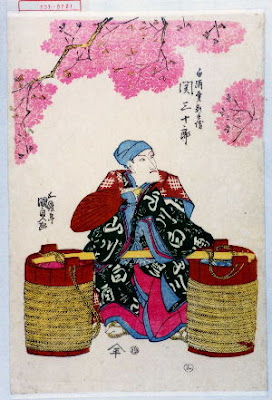


 The style of sakuramochi differs from the regions in Japan. Basically, the east of Japan such as Tokyo uses shiratama-ko (白玉粉, shiratama-ko rice flour) and the west side such as Kansai uses dōmyōji-ko (道明寺粉, dōmyōji-ko glutinous rice flour) for batter.
The style of sakuramochi differs from the regions in Japan. Basically, the east of Japan such as Tokyo uses shiratama-ko (白玉粉, shiratama-ko rice flour) and the west side such as Kansai uses dōmyōji-ko (道明寺粉, dōmyōji-ko glutinous rice flour) for batter.





